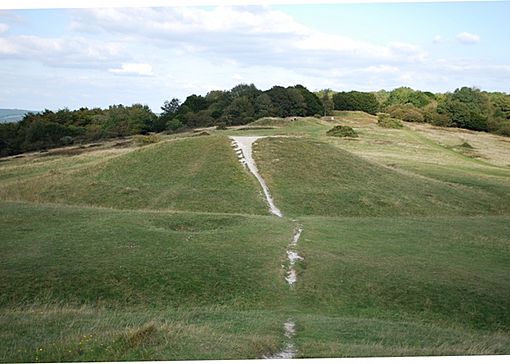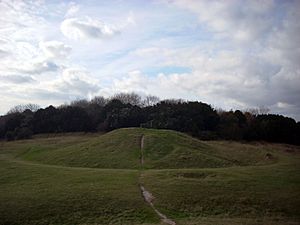Devil's Humps, Stoughton facts for kids
The Devil's Humps are four ancient burial mounds, called barrows, from the Bronze Age. They are also known as the Kings' Graves. You can find them on Bow Hill in the South Downs area, close to Stoughton, West Sussex. These impressive mounds sit on a ridgeway, which is a high path, above a special nature reserve called Kingley Vale.
The Devil's Humps are considered some of the most amazing round barrows still standing on the South Downs. They are part of the Kingley Vale National Nature Reserve. Two of the barrows are bell barrows, and two are pond barrows. There's also a cross dyke nearby. These are all protected as Scheduled Ancient Monuments.
Contents
What are the Devil's Humps?
The four mounds form a small ancient cemetery. They are lined up from southwest to northeast. The two mounds at the southwest end are very close together. These are bell barrows, and they have a small dip or bank between them. The two mounds at the northeast end are bowl barrows.
All four barrows are lined up and stand about 3 to 4 meters (10 to 13 feet) high. Even though people explored them a long time ago, causing some damage, they are still quite tall. We don't have records from these early explorations, so we don't know exactly when they were built. However, experts believe they were made in the late Neolithic period or early Bronze Age. It's also possible that people used them again during the Roman and Anglo-Saxon times.
The barrows are named A, B, C, and D, starting from the southwest (A) and going towards the northeast (D).
Barrow A
Barrow A is a bell barrow. It measures about 22 meters (72 feet) across. It has a raised flat area, called a berm, which is about 3.7 meters (12 feet) wide. Around the berm is a ditch, also about 3.7 meters (12 feet) wide and 0.5 meters (1.5 feet) deep. This barrow stands about 3.7 meters (12 feet) high.
Barrow B
Barrow B is also a bell barrow. It's about 24 meters (78 feet) across and has a berm about 4.6 meters (15 feet) wide. The mound itself is about 3.7 meters (12 feet) tall. A ditch goes around the berm. This ditch is about 3.7 meters (12 feet) wide and 0.5 meters (1.5 feet) deep.
Barrow C
Barrow C is a bowl barrow with a ditch around it. It stands about 3 meters (10 feet) high. It measures about 28 by 26 meters (92 by 85 feet). The ditch on its northwest side was filled in when a boundary bank was built. The middle of this barrow has been dug into before.
Barrow D
Barrow D is another bowl barrow with a ditch. It also stands about 3 meters (10 feet) high and is about 24 meters (79 feet) across. Like Barrow C, its center has been damaged by earlier digging. Parts of it are now covered by plants like brambles.
Possible Pond Barrows
Experts have found two other possible barrows nearby. One is between Barrows A and B, and the other is northeast of Barrow B. They look like small dips in the ground, about 8 meters (26 feet) across and 0.8 meters (2.6 feet) deep. They might be pond barrows, but they are quite small.
What was found during excavations?
The two bowl barrows, C and D, were looked at in 1853. Barrow C was opened up. It was clear that someone had already disturbed it before. However, some interesting items were still found. These included burnt bones on top of burnt soil, a whetstone (a tool for sharpening), a horse tooth, antlers, and pieces of pottery from the Iron Age. These items from Barrow C are now kept at the British Museum.
Barrow B was dug into in 1933. On its surface, people found a flint scraper from the Bronze Age and pieces of pottery from either the Bronze Age or Iron Age. These finds are now at Lewes Museum.
Other Ancient Sites Nearby
There are many other ancient remains around Bow Hill and in Kingley Vale. These include other cross dykes and earthworks (old banks and ditches). There are also old settlement sites in the Vale itself. You can find two Iron Age hill forts, one of which is Goosehill Camp. Plus, there are several long barrows (another type of burial mound) on Stoughton Down to the north.
Folklore and Legends
The Devil's Humps are part of many local stories and legends, especially those connected to Kingley Vale. One famous story tells how the people of Chichester fought and defeated a Viking war party in the Vale. The Viking leaders were supposedly buried in the Devil's Humps, which is why they are also called the Kings' Graves. Many other Viking warriors are said to have fallen where they died, under the yew trees on the hill.
People say that the ghosts of these Viking warriors still haunt the yew groves. Some even believe the ancient yew trees themselves come alive and move at night! This legend might come from a real battle. The Anglo-Saxon Chronicle, an old historical record, mentions a fight between the people of Chichester and Danish raiders in the year 894 AD.
The chronicle says:
When the host that had besieged Exeter sailed back on its way home, it harried inland in Sussex near Chichester, but the garrison put them to flight and slew many hundred of them, capturing some of their ships.
—G. N. Garmonsway (ed.), The Anglo-Saxon Chronicle 1953, 1992, p.88.
This means that when the Viking army was going home, they attacked near Chichester. But the local defenders fought them off, killed many hundreds of them, and even took some of their ships.



